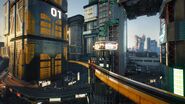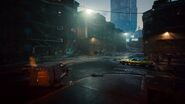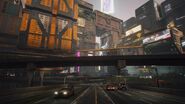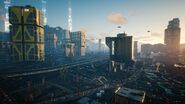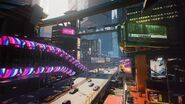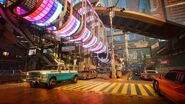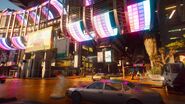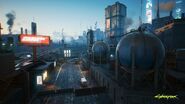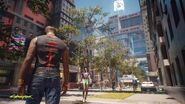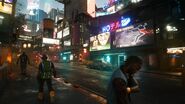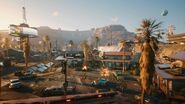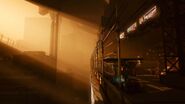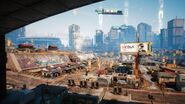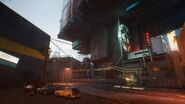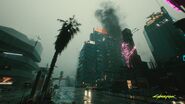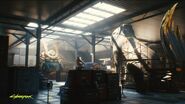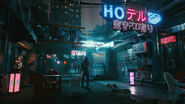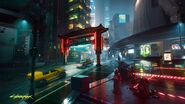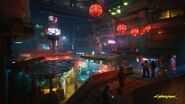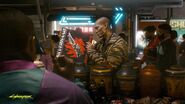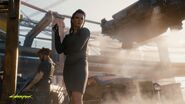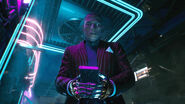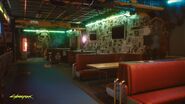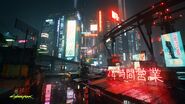– Bes Isis, N54 newscaster, Cyberpunk 2020
The Free City of Night City[5] is an autonomous city located on the border between North and South California, on the Pacific coast of North America. It is considered a modern multicultural and thriving metropolis of the 21st-century, overrun by corporations, corruption, organized crime and gang violence.[1]
By 2077, Night City was voted the "Worst place to live in America".[6]
Overview
Night City was established at the head of Del Coronado Bay in 1994. Founded by Richard Night, it was originally known as Coronado City before its renaming in 1998.
Night City has wide streets and dense urban skyscrapers which are home to almost seven million people by 2077. It operates as a city-state, officially owning the title of Free City, and with the Arasaka Corporation having almost complete control over it. This metropolis is considered a thrilling and exciting location to visit, as well as an interesting and vibrant place to live for those of means, and a hellscape to the city's disenfranchised; its world famous slogan is "The City on the Edge of Tomorrow", and more recently "The City of Dreams". Technologically triumphant over the troubles of the past United States of America, a combination of cultures of the Old World, and a new beginning of the NUSA; Night City is now.
History
Inception: 1990 - 1994
Night City was the brainchild of Richard Night, a successful businessman who during the 1990s was concerned by the violence and disruption of the impending Collapse. Working mainly on corporate-funded projects soon started not to be enough for him, and seeing himself in an uniquely position to deal with the problem, Richard started a side company known as Night International, and began to plan an ideal new city — an environment that would be controlled and would be ultimately safe from the ravages tearing the world apart.[1] His new city would be completely planned, self-sufficient, and capable of holding off even the most determined marauders. It would boast planned neighborhoods dedicated to preserving the feel of different types of nationalities and cultures, as well as a super-modern corporate center that would stand as a shining beacon of enlightened capitalism.[7] It was ambitious, far-reaching, and visionary in its approach.[8]
Night's secured an unheard amount of capital needed to finance the gargantuan project. With the Collapse, many corporations were looking to establish their own urban areas - controlled zones free of crime, poverty or debt. A place where governments would be corporate-run, allowing optimum zoning and no anti-business elements to interfere with corporate growth. Ideally, it would be a capitalist mecca of opportunity. Night's dream city was tailor-made for their purposes and so he provided the design and construction capacities. By 1992, Arasaka, EBM and Petrochem had all signed on with Night.[1]
Richard Night sent scouting teams to the East and West Coasts of the United States, but it was a small article in the San Francisco Chronicle that caught his eye - the article described an incident of post-holocaust horror that had taken place in a small town called Morro Bay, along the Central Californian coast. Now a ghost town, Night was able to buy the remnants of Morro Bay for a very cheap price. Also aided by Petrochem, who had taken over the then-abandoned Dynergy power plant in the town and was already planning to set up an offshore port and oil terminal site.[7] A leveraged 132 million dollar purchase secured the remaining parcels.[1]
Bankrolled by Merrill, Asukaga, & Finch, Night and Petrochem hired the Arasaka Corporation to remove the boostergangs and make the area a safe zone for construction. Further funds came from external investors lured to the project by the promise of lucrative building contracts and possible sources of extralegal income. In order to erase the stigma of the Morro Bay Massacre, the partnership renamed the area Del Coronado Bay, the site of their new project of Coronado City.[7]
By 1993, Coronado City required more terrain than what the geology of the bay currently had. To fix that, the partnership leveled the surrounding hills and dumped them into the ocean as fill. They reshaped the bay in order that the formerly narrow sand spit to the west was widened to about 10 miles, and also re-dredged the harbor making it capable of porting the large ships needed to build the city, with the remaining dirt also ending up as fill on the western edge. There were also plans to build a station for the Planetran intercontinental maglev, as the region was an ideal location for one.[1][7]
Construction: 1994 - 2005
In May 1994, the construction begun. Although Petrochem and MA&F were the major bankrollers for the Coronado Partnership, they weren't construction companies, a problem that eventually led to employ the workforce of the mob. The West Coast Mobs - such as the Mafia, Yakuza, and more - had maintained a stranglehold on heavy construction. They controlled the construction unions, the transport unions, and most of the governmental agencies in charge of construction licenses, environmental impacts, and other building necessities. The Mobs hoped that by investing a large amount of money in the Partnership, they would not only make a huge sum of return on lucrative construction work, but also have the inside track on future gambling, prostitution, and drug franchises in the new city. However, Night's plan required the use his own advanced building techniques and materials; which excluded a number of established unions and construction firms controlled by their new Mob partners, including his old associates - now called Halsey, Ferris, and Skiv. This displeased them, and Night's further insistence that his new city would be safe and crime free angered them even more.[1][8][7]
During the first four years of construction, there were daily threats against Night's life, and when the threats escalated to the level of sabotage and intimidation, he called in his corporate partners, who dealt with the issue swiftly and ruthlessly.[1] However, despite his influence and his allies promising to deal with it, Night's luck ran out. On September 20th, 1998, he was shot and killed in his penthouse suite at the top of the newly constructed Parkview Tower.[1] Night's killer was never apprehended, and in his memory, the newly appointed City Council officially renamed Coronado City as "Night City" in his honor.[7]
A year after her husband's death, Miriam Night restructured Richard's company and founded Night's Foundation, with the primary goal to protect and promote her husband's vision of the perfect city. This foundation would eventually rose up to become Night Corp.[6] During this, the mob bosses who had killed Richard begun to appropriate of most of the city.[7] The next seven years were chaotic as the different powers battled for control of Night City.[1]
Mob Rule: 2005 - 2009
By 2005, the mob had become the dominate force in the Del Coronado Bay area. The corporations established their strongholds in the outlying "beavervilles" and the newly constructed Corporate Plaza. Originally the corps had little interest in running Night City, and the City Council was unable to lead without them.
During the next four years, much of the city's government was replaced by corrupt mob-selected puppets. By selling contracts to their colleagues, setting up drug and extortion deals, and inviting the the worst of the Collapse into the city, the mobs managed to turn a relatively clean, modern metropolis into an embattled war zone. Crime, drugs, prostitution, random violence, and cybernetic terrorism soon became the rule of law. By 2009, the name Night City had taken on a grim and deadly new meaning.
These years were the "dark ages" of Night City, with more murders in that last four-year span than there were for most cities in ten. The mob ruled the city with an iron fist, killing anything in its way. Gang activity was at an all-time high during this period, with notorious gangs like the Blood Razors or the Slaughterhouse making their debut. Night City soon became the closest thing to hell on earth, and the number of unsolved murders documented by the Night City Police Department had risen into the thousands.[7]
Mob War: 2009 - 2011
After four years of street warfare, in 2009 the corporations around the city finally decided they'd had enough. From 2009 to 2011, during the period of conflict now called the Mob War, the corporations battled the underworld for control of Night City.[1]
The corporations involved had their own agendas that conflicted with the Mob. Led by Arasaka-trained paramilitary troops in assault vehicles, fan tanks, and combat aerodynes - a wave of bombings, assassinations, and outright street battles descended upon the mob's ill-prepared cadres. When the smoke cleared, the corporations had utterly destroyed the mob's power base in Night City.[7]
At the end of the Mob War, the corporations placed a puppet mayor in power and started cleaning up the rest of Night City. The newly elected City Council - faced with the return of chaos in in the city - deputized corporate security forces and allowed them full authority within city limits. The corporate and city centers were cleaned out and restored to their pristine states. The other neighborhoods were also cleaned out and made livable again, mostly. The corporate draconian policies contributed to the city's chronic homeless problem. This ultimately put hundreds on the street as affordable housing was upgraded and used to house the troops the corporations needed to maintain order. In the following years, this situation eased as fewer enforcers and security teams were needed to keep the streets safe.[1][7]
2013
By 2013, much of the worst excesses of Night City had been crushed under the ruthless heel of the megacorps. The basic services such as police, firefighters, and support services had been reestablished.[7] In April the 13th of that same year, famous rockerboy legend Johnny Silverhand held a concert outside the original Arasaka Tower and led a strike team into the tower to rescue his girlfriend Alt Cunningham. The tower was damaged badly after the attack and repaired over the coming years.
2020
By 2020, Night City was a rapidly growing urban region, still rife with urban violence and street crime, but with strong economic growth in the corporate sector. It was the quintessential city of the future—gritty - dangerous, but possessing an urban slick and stylish cool that made it unique. The city had all but healed from the ravages of its bleak past. The Corporate Plaza was always pristine, and the NCPD had enough power to keep down the downtown streets fairly safe during the day. But as with most American urban areas, Night City had also devolved into an armed society. It wasn't strange to see as many guns as briefcases on the crowded city streets, and even though the days of complete chaos were in the past, danger still persisted.[7]
Night City had evolved into a busy, successful, and dangerous urban zone. The government managed to keep the lid on, and when they failed the corporations could be depended on to re-screw the lid down with their own brand of violent and implacable savagery. It wasn't the utopian city of Richard Night's futurist dreams, but overall, 2020's Night City worked.[1]
Fourth Corporate War: 2021 - 2023
Because of its Free State status, Night City was home to units on both sides of the 4th Corporate War. As many other cities, Night City was also caught in between the power struggle of Arasaka and Militech. While some cities were evacuated due to the conflict, such as Rio de Janeiro or Busan, Night City was the only one destroyed by a mini nuke. The Arasaka Tower was 140 floors tall, making it among the tallest building that existed at the time. With the exact location of the Arasaka master database unknown, Militech decided the best course of action was to use a pocket nuke (carried by a hand–picked black ops team) to level the entire structure. The Militech team didn't even consider the amount of devastation or the death toll, as they had already written the city off as a loss.
The bomb triggered in the Arasaka Tower was roughly twenty–five percent as powerful as the bomb at Hiroshima; a tactical nuke a bit larger than a "suitcase bomb." It was designed to utterly demolish the master database and make it unusable in any way to a rival Megacorporation. The Nuke was prematurely detonated at floor 120 (1200 feet), in Kei Arasaka's apartment where the Soulkiller lab was located. The immediate blast killed 12,000 instantly.
The blast obliterated the tower, splitting it in half and causing as it collapsed outward. The entire center of the city became rubble in seconds. Much of Night City was built on fill, due to the original elevation only being sixteen feet above sea level. The nuke in turn caused a minor earthquake that liquefied parts of the fill and flooded the inner city.
The explosion was technically an air blast since the detonation went off at roughly 1,200 feet. While this lessened overall long–term radioactivity, most of what remained penetrated only the huge skyscraper towers surrounding the blast. The high blast area and the tons of raw concrete and steel there were instantly converted into particulate debris which rained down on the entire NorCal region and far out to sea for many months after.
The dust cloud spiraled up into the sky, turning it red for almost two years. Even several years after the blast, suspended particles would cause the skies at dawn and dusk to glow a lurid crimson. As a result many of the people who lived through this time deemed as "Red" or "The time of Red."
After the Fall: 2023 - 2025
Night City was made inhabitable within 24 hours of the detonation. Many people were unaffected as they were heavily cybered up or had radiation filters installed in their bodies already. However, the Nuke and its aftermath destroyed a large part of Night City's housing, forcing people to move out to the suburbs or to areas even further out from the city' center. The liquefaction of the fill the city was originally built upon broke gas mains, water pipes, and electrical grids. Streets became twisted chunks of asphalt, strewn with wrecked ground cars, while fallen AVs lay scattered among the debris of broken skyscrapers. Despite the hardships Night City still wasn't as bad as some other cities like Rio, Busan, or Hong Kong.
Much of the area beyond Greater Night City had been abandoned during the Collapse. People in the thousands started moving north, south, and east as soon as they could. Neighborhoods found a new unity and purpose, even if it was grudgingly built on shaky foundations. The people weren't looking to rebuild, as the priority was to look for food, clean water, and shelter.[7]
The Recovery: 2025 - 2035
President Elizabeth Kress, and ex-Militech CEO, blamed the Night City attack on the Arasaka Corporation, however she was able to determine that the actual weapon used had been supplied by a Militech strike team. The "Big Lie" was that Arasaka blew up the Corporate Center in a denial attack to stop Militech from seizing the Arasaka's Night City office.
Very few people knew anything about the Militech–backed strike team or its composition. Rumors circulated that the veteran solo Morgan Blackhand, operating as a hidden government asset, passed the information about the failed raid onto President Kress independently. Kress used this over Militech, bringing the American-based corporation to its heel and led to the nationalizing of its assets as part of a resurgent NUSA government. Bringing the full force of her military and propaganda resources to bear, Kress painted a lurid picture of Arasaka as an evil foreign megacorporation run by a madman, who wanted only the destruction of an American city in the pursuit of personal power. Arasaka's charters to operate in the NUSA were immediately revoked, its members and board were declared terrorists, and its assets either seized or driven off-shore.
Despite all the political play, Kress showed little to no interest in helping Night City recover. Much as previous Presidents during the Collapse had done, she wrote the city off as unrecoverable and offered sanctuary in a New United States to the surviving refugees. There were two reasons for this; first, with the resources of the NUSA already stretched to the breaking point, there were too few options left for her. Second, the flinty and farsighted American President saw this as the perfect way to bring the wayward Free State of Northern California back into the government's control. Night City however, resisted the rule of the New United Sates.[7][6]
The Rebuilding: 2035 - 2069
Roughly two million people in the greater Night City area were left homeless due to the bomb, either directly or because of the flooding from the liquefaction of the city's foundations - which were built on fill and sand. Survivors fled into overcrowded tent shanty towns in the surrounding suburbs of North Oak, Westbrook, Pacifica, Heywood, and South Night City. But soon enough it was obvious that something needed to be done quickly.
The remnants of the Night City government and its citizens turned to outside resources, calling in old markers and favors from a wide variety of people - including nomad families, small corporations and edgerunners. Recovery was lead by the Aldecaldos nomad clan and their allies in the StormTech Corporation. With a lot of experience in city rebuilding due to the Chicago project, StormTech and the Aldecaldos were uniquely equipped to construct extensive temporary housing from shipping containers, and afterwards formocrete modules brought in by rail and sea. Firstly though, the ground needed to be cleared to put up even these rudimentary structures.
Most of the central corporate zone had been destroyed, including the government buildings. The wreckage was far too vast to dig up and cart to distant landfills, so the survivors used bulldozers and jury–rigged main battle tanks - abandoned by both sides - to shove the debris into the bay. Night Corp offered generous rewards to anyone willing to help clean up the crater of radioactive rubble at ground zero. Both the corporation and the City Council claimed that casualties were kept to a minimum, while at the same time they didn't provide official statistics to substantiate said claim.[9] Much of Night City's inner neighborhoods had already been razed to the ground in the ceaseless battles preceding the Fall of the Towers, so the wreckage became the fill that new megabuildings and old cityscapes used to rise again, once more ready to challenge the smog-filled skies.
Many of the old districts had become a part of the new Combat Zone, and the original heart of the metropolis was still completely devastated. By 2045, Night City was still in the process of rebuilding.
This ongoing rebuilding period cemented Night City's relationship to the outer world. Abandoned by President Kress and the New United States, Night City had no intention of ever going back into their failing fold. At that time, there was a rampant speculation that the NUSA government had used Arasaka as a spacegoat for the nuclear detonation, obtaining with this the opportunity to slander the corp's reputation. It was at some point of 2045 when the truth was finally unveiled.
Trace Santiago, a young independent media, managed to obtain information about what truly went down in 2023, writing several exposes and books about the Fourth Corporate War. With this story published, the Big Lie - the deception created by President Kress to blame Arasaka for the AHQ Disaster - completely crumbled. This publication backfired spectacularly against Militech and the NUSA, driving Night City to realign itself with Arasaka rather than the United States. After these revelations, it was a common opinion that Night Citizens would prefer to see the return of the Asian corporation than submit to federal rule. The city was even prepared to request aid from the Arasaka if the Union ever tried to take back Night City by force.
As for the EEC and Soviet Union; Night City council considered them pleasant trading partners as long as they didn't disrupt the harmony of the city.[7][6][10][11]
In May 4th 2063, the Avian Extermination Act was approved by the City Council after a series of zoonotic disease outbreaks, eliminating all birds within 18 miles of the city limits. Personal pets could be kept though. Progressively, most of the animal wildlife in NC disappeared too.[12]
During the mid-2060s, the new Pacifica project was approved. With the economic recovery, investors sought an opportunity to make money on tourism. Billions of eurodollars were poured in an attempt to turn the southern suburbs of Night City into a booming tourist resort. Construction was well underway when the Unification War started. Most investors withdraw their funding, abandoning Pacifica and leaving it to the locals.[6]
2069 - 2076
At the end of 2069, the recently elected NUSA President Rosalind Myers, ex-CEO of Militech, proposed a federal rule designed to bring the Free States to heel by federalizing them under the pretense of strengthening the nation. Most of the American fully autonomous states opposed this unification, and conflict soon followed between the NUSA and and a number of Free States - the Unification War.
Night City - at the time part of the Free State of Northern California - wanted to remain neutral in the conflict. NorCal had allied with the rest of Free States while SoCal had decided to back the NUSA government, thus positioning Night City in the middle of two warring states. Its citizens held their breath as they waited for federal troops to invade, though in the end they managed to barely avoid the fight. In early 2070, while a division of federal troops were advancing towards the outskirts of Night City, the then-Councilman Lucius Rhyne used his decade long list of contacts to beg the long-shunned Arasaka Corporation to protect them. A few days after the councilman's plea, an Arasaka supercarrier appeared in Del Coronado Bay and mere hours later the NUSA troops retreated.
Not long after Arasaka's open intervention, the Treaty of Unification was signed in June 2070, putting an end to the war. President Myers feared the increased presence of Arasaka could escalate the conflict, something the NUSA was not prepared for at the time. The treaty was unsatisfactory to all parties but was preferable rather than to continue the war and risking another global crisis.[6]
The treaty also rededicated Night City as an international autonomous free city, without having to answer the governance and laws of North California or the NUSA, and obtaining the title of Free City. However, this new liberty was paid costly as it allowed the megacorporations to further increase their rule over Night City, pumping money into its revitalization in order to establish a foothold on the North American West Coast. The symbolic pinnacle of this event took place that same year when the Night City government - which included the newly elected mayor Lucius Rhyne - gave Arasaka a seat in the City Council and allowed them to build their new American headquarters in the downtown area, on the site where their previous office had been destroyed in 2023. The city felt prosperity again, but it was not enjoyed by all.[13]
During this time, some investors tried to restart the Pacifica project, but they were met with resistance from the local community. The NCPD attempted to clear the area but to no avail. In fear of a bloodbath, the chief of the NCPD ordered the withdrawal and soon afterwards the City Council shut down all city services there to force the locals to leave - this attempt prove unsuccessful. Slowly, Pacifica turned into a new Combat Zone within the Night City area.
In the following years since their comeback, Arasaka extended its dominion over Night City. They were able to take out a number of corporate rivals, and build the impressive, yet ominous Arasaka Waterfront in Watson.
In 2074, Night City celebrated the eightieth anniversary since its founding.[6]
2077
By 2077, Mayor Rhyne was due for re-election. Councilman Jefferson Peralez, a staunch adversary of corporate influence, planned to run against him.[6][14] Rhyne unexpectedly died, with the official cause of death attributed to the implants regulating his heart malfunctioning. Deputy Mayor Weldon Holt became Acting Mayor, and a new election was called in which both Holt and Peralez announced they would run, along with several other unidentified candidates. Peralez eventually prevailed over Holt and the other candidates in the election, winning either a majority or a plurality of the vote, and became the next mayor of Night City.[12]
Geography

Night City metropolitan area.
Night City is located on the West Coast of the NUSA in Del Coronado Bay area, as negotiated in the Northern Separation Treaty of 2012. At that time, Night City was considered to be part of the Free State of Northern California; that being said, access was guaranteed to travelers from Southern California. Nearby city travel ranges from 4 to 6 hours to San Francisco and Los Angeles, depending on road gang conditions and road quality.[7]
After the rebuild stage, the city's location remained largely the same, with slight differences it the landscape around it. Night City is surrounded by the Badlands region, which is mostly unpleasant, however due to the protein farms of Biotechnica the south side is considered not as bad as the eastern part of the region.
1990 distribution
After buying out the terrains of Morro Bay and its surroundings, Richard Night begun to construction of his city by first rearenging the terrain. Keeping with Night's vision, Coronado City was originally divided into neighborhoods - each with a different architectural style and theme - much like the original Disneyland park. Night hoped to bring in a vibrant multi-cultural population attracted to each neighborhood.[7]
2020 distribution
With Richard Night's death, the then renamed Night City disintegrated into a hodgepodge of competing districts, savaged by gangs, and later controlled by domineering megacorporations. Besides the neighborhoods, the city was also surrounded by larger suburban areas.[7]
In the original Cyberpunk 2020 RPG, the city was additionally ordered by Sections, being A through C the Central Night City, D the violent crime-ridden hell known as the Combat Zone, and E through J the wider suburban areas.[1]
| Locations | Districts & Areas |
|---|---|
| Central Night City | Little Asia, Little Europe, Upscale Brownstones, City & Corporate District, Nightlife District, University District |
| Combat Zones | Combat Zone |
| Suburbs | South Night City, North Oak, Westbrook, Heywood, Rancho Coronado, Pacifica |
| Pacific Ocean | Morro Rock, Del Coronado Bay, San Morro Bay |
| Other Areas | Del Coronado Bridge, Badlands |
(Cyberpunk 2020)
(Cyberpunk 2020)
(Cyberpunk RED)
2045 distribution
Night City was devastated during the Fourth Corporate War. After the nuke, the majority of the population became homeless and the sky was red for decades - a period known as the Time of the Red. During the next decades, Night City was in the process of rebuilding. The old neighborhoods of the 2020 period had been rearranged, renamed, or even scraped off into the bay if they were still too radioactive. Many of the old districts had also become a part of the extended Combat Zone, and the original heart of the metropolis was still completely devastated. Locals began to refer to these areas based on the type of environment they were dominated by. In addition to the urban re-designation, each new area was given a "threat rating" by the City Council - a designation of how dangerous the area was.[7]
| Locations | Zones & Areas |
|---|---|
| Rebuilding Urban Zones | The Glen, Little Europe, Upper Marina, University District, Watson Development (NorCal Military Base), Pacifica Playground |
| Combat Zones | Old Japantown, Little China, Old Combat Zone, South Night City |
| Hot Zone | Old Bank Block, Old City Center, Old Corporate Center, Old Medical Center |
| Overpacked Suburbs | Heywood-Santo Domingo (Heywood Industrial Zone), New Westbrook, Rancho Coronado |
| Del Coronado Bay | Morro Rock |
| Other Areas | Executive Zone, Reclaimed Perimeter, Open Roads, Badlands |
2077 distribution
After the Time of the Red and the Unification War, Night City was mostly rebuilt and had maintain its autonomy. By 2077, the city was overrun with crime, its rate doubling than that of the NUSA. The homeless population had been a problem since the early 2000s, and in 2077 had risen 300%. Each district is dominated by at least one gang.[15] The city is divided into six districts, each with their own environment and denizens. There are 16 sub-districts and the total size of the city is 75.42 km².
| Districts & Locations | Sub-districts & Areas | Information | |
|---|---|---|---|
| City Center | Downtown, Corpo Plaza | That's City Center – Night City's corporate showcase. Sleek skyscrapers form a brutalist, fortress-like skyline, presenting the unrivaled power of megacorps in all its arrogance. Since 2020, the City Center has become the most fortified and secure part of Night City. | |
| Heywood | Wellsprings, The Glen, Vista del Rey | Heywood is a neighborhood of contrast—from modern skyscrapers and parks in the north, to dangerous, inhospitable slums in the south. It's "the biggest bedroom in Night City", where gangs like Valentinos and 6th Street get down to business—legal and illegal alike. | |
| Westbrook | Japantown, Charter Hill, North Oak | Westbrook is considered by many to be the best place to live and have fun in Night City. If you've got eddies, you come here to spend them. And if you don't? Well, take out a loan and pretend you're on top of the world — even for just one glorious night. The Tyger Claws own this turf and operate many businesses. | |
| Watson | Little China, Kabuki, Northside Industrial District, Arasaka Waterfront | Watson used to have it all. Nightclubs, skyscrapers, corporate offices, a top-end medcenter — but economic disaster put an end to all that. Now, it's known as 'the bad neighborhood of Night City'. The kinda place that suits gangs like Maelstrom and Tyger Claws down to the ground. | |
| Santo Domingo | Arroyo, Rancho Coronado | Santo Domingo is one of Night City's oldest districts. Corporations use it as a testing ground for industrial projects, destroying old factories just to build new ones, while residents scrape a desperate living in crowded megabuildings — wishing for something better. | |
| Pacifica | Coastview, West Wind Estate | Pacifica could've been Night City's money-making vacation resort, but once the investment dried up it became a husk left to rot. Now, instead of tourists, the district is overrun by gangs and violence, with The Voodoo Boys protecting the community forsaken by NCPD. | |
| Badlands | Northern Oilfields, Eastern Wastelands, Southern Desert | Sparsely populated by nomads, the Badlands are the vast plains outside of the city proper. Unchecked resource extraction, burning oil fields, rampant pollution; this district makes Night City feel like a rich oasis. But it holds golden opportunities for those in the know. | |
| Del Coronado Bay | Morro Rock (Orbital Air Space Center) |
Climate
Night City's Northern Californian location gives it one of the most pleasant climates in the Western part of the NUSA. Normal temperatures range from the mid 80°F to low 50°F (26°C to 10°C), with misty white fog blanketing the City in the early mornings and evenings. Night City receives around 21 inches of rainfall each year. Of this water that drops, around 35% contains toxic chemicals which is higher than the current government standards for the United States produced vehicles, clothing, and food. On average, if a person's vehicle and clothing are rated above SP 12, adverse effects (staining and ablation) will be negligible.
When one visits Night City, they should wear light to medium weight clothing, with a light armor jacket or ballistic-cloth overcoat which is optional. A filter mask and supplemental oxygen are highly recommended as well, this is a hedge against inversion smog and acid rain fog. That being said, acid-proof slickers, umbrellas, and air masks are readily available from the sidewalk vendors or smaller street stores during a smog warning periods. The average cost of these items can range from €$20 to €$35.
Government and politics
Night City is a democratic mayoralty with a corporate-controlled city council. In mayoral elections, votes are cast via a dataterm using IdentiCard registration software, and the winner of an election is determined by a simple majority of the popular vote. The Night City Council consists of 100 members, each of whom are usually backed by one of the top ten largest corporations present in Night City.
In 2045, the Time of the Red, Night City's government continued to exist in a technical state of emergency due to the destruction and disruption caused by the Night City Holocaust in 2023. The office of mayor had been left vacant for years, and the city was instead ruled by the Night City Council, which took the form of a junta representing survivors of the previous city government, Edgerunner and Nomad factions, and the corporations Zetatech, Biotechnica, Petrochem, and secretly Arasaka. The Council appointed District Managers to oversee basic services in each of the city's districts. Without a mayor or strong central leadership, friction between the Council's factions frequently led to disputes that were sometimes settled with violence on the streets. Since no single faction was able to gain a decisive advantage over the others, they all kept to their own areas of interest as much as possible to keep fighting to a minimum.
Night City's Mayor
The Mayor of Night City oversees the Treasurer's Office, the deputies to the mayor, and directs the heads of the city's departments, including the NCPD. He or she is the city's highest governing representative. They have the power to appoint department heads and commissioners as well as remove public officials from office.
The city's system of governance is based on the authority of the mayor in cooperation with the City Council. Part of the mayor's proposals are subject to approval from the council.
With every new mayor comes an office with new personnel.[16]
Mayors
- Mbole Ebunike (2012 - at least until 2023)
- Garven Haakensen (succeeded Ebunike)
- Lucius Rhyne (2070 - 2077)
- Weldon Holt (succeeded Rhyne as acting mayor in 2077)
- Jefferson Peralez (2077)
Night City Council
The Night City Council is one of the ruling bodies of Night City. Its 100 members are elected along neo-democratic lines by the then largest corporations headquartered in the city.
The city's system of governance is based on the authority of the mayor in cooperation with the Night City Council, as such, part of the mayor's proposals are subject to approval from the City Council.[16]
Councilmen
- Lucius Rhyne (early 2060s - 2070)
- Jefferson Peralez (Unknown - 2077)
- Eva Cole (Unknown - 2077)
Economy
Business sectors
The business sectors of Night City include manufacturing industries, international trade and commerce, information services, electronic technologies, security services, and so on. While cities like Tokyo, New York City, or Singapore have been overrun by corporations by the 2000s, Night City was the only city in the world that was built by the corporations. Some of the biggest megacorporations in the world contributed to the construction of the city and many were located in the Corporate Center in 2020. After the war, and the subsequent rebuild stage of the Night City, the Corpo Plaza became a symbol of the megacorps grasp on the city.
Corporations
The following were some of the leading corporations that helped construct the city, but it's just a few of the ones that still operate in Night City. The city is overrun by many corporations and businesses, some of which are exclusive to Night City. Without the official aid of U.S. government or the free state, Night City is a free nation that sees little interference from the outside. Night City's biggest ally is Arasaka, which keeps the city running and protected.[1]
Coronado Partnership
Post-founding notable corporations
- Biotechnica
- Kang Tao
- Kendachi
- Kiroshi Opticals
- Militech
- Orbital Air
- SovOil
- Trauma Team International
Infrastructure
Transportation
Night City hosts a extensive network of urban freeways and rapid transit networks. Getting from the city's various districts is seamless and effective except for in districts where the infrastructure has been damaged such as in Pacifica. Interstate 828, 928 and 16 are freeways in 2020 although it is uncertain whether these have since been renamed, rebuilt or remain unchanged in 2077. Also, the Orbital Air Space Center is a aerospace center in Night City, allowing for space transportation.
Airports
In 2020, the Night City Metropolitan Airport was the sole airfield around NC. After the War, a new airport and Orbital Air Space Center were built on the Morro Rock island, west on the bay.
Law enforcement and crime
Operating as a city-state in 2077, a sovereign nation separated from the rest of the NUSA, Night City's borders are patrolled by Arasaka contractors. The Night City Police Department holds jurisdiction over domestic security, although the personal security detail of the mayor is handled by a team of handpicked corporate huscle.
Database Entry (2077)
Night City
- The City of Dreams was founded in the 1990s by visionary industrialist Richard Night. When the world of late 20th century plunged into chaos, Night envisioned a modern metropolis free from crime, poverty and corruption. Corporate partners Arasaka, EBM, and Petrochem helped him realize this vision, investing in the foundation of what would become the Free City of Night City. The city would develop into a haven for young idealists and a beacon for others who sought to fulfill their own dreams. And although Richard fell to assassins and many new generations seeking fame, fortune and freedom have suffered their own series of setbacks, the city's legendary status endures today.
- Night City has it all: from the monumental skyscrapers of industry-leading megacorporations, to the luxury villas of world-renowned stars, to the lawless neighborhoods where war is waged every day. You will stumble across mercenaries, gangs and famous rockers, but also junkies, bums and even cyberpsychos. You will stand in the shadows of colossal megabuildings and get lost in the maze of streets, alleys and markets. You will make your dreams come true or die trying.[12]
Animals
- Animals are a rare sight in Night City, but it wasn't always like that. Once upon a time you could hear the cries of seagulls at the marina, swat your way through swarms of flies at the bazaar, and best of all - step in dog shit at the park. Everything changed in the second half of the 21st century, when the city was brought to a standstill by animal-borne diseases. In 2051 - seven thousand victims. 2059: ten thousand. 2061: twelve thousand. The panicked city council decided to eliminate all birds in the city, while exterminators started using military equipment for traps and fumigation. Personal pets could be kept, though owners were saddled with huge tax bills.[12]
Real location
According to Mike Pondsmith and R. Talsorian Games, Night City occupies the same area as Morro Bay and Baywood-Los Osos, two towns located on the Californian central coast. But the geography has been heavily modified in the lore and it doesn't really resemble the real location anymore.
- Night City was created on the "bones" of Morro Bay, a town I often drove through on my various road trips. I liked the place and in one of those flights of fancy young designers have, I wondered what it would take to buy the whole thing. The basic structure is still there in the Night City map, if one allows for an impressive amount of fill required to build out the upper area around the "Rock." (this is not unthinkable--a large amount of downtown Seattle and San Francisco were both built on fill: image). I actually have a map that shows how the whole thing goes together geologically; one day I'll have to post it. And no, it's NOT in Coronado in southern Cali. I used to live in San Diego, and I know the difference. ;)[17]
- I'm surprised that this is news; I wrote this out years ago and it's no secret. I picked the location because it matched the general terrain and geology I wanted, and was at a choke point on the Cali coast that would be perfect for the Free State. The names were generally picked out of a hat from all the places I've lived in California over the years--there's no real rhyme or reason there. Here's a reconstruction of what I was doing back then in 1980-something... image Yes, the Rock is to the very north of Night City in my original design. I just didn't point it out at the time. In my personal campaigns, it's been built into a fortress/arcology kind of like a mini Gibraltar. But your mileage may vary. However, remember that Night City is a heavily fictionalized locale and there's no reason that the end result has to look like Morro Bay. I've given CDPR plenty of room to mess with stuff as they see fit. So don't take this musing about a 30 year old decision too seriously, neh?[18]
- I never expected this to be that interesting. Night City started out as a map of Morro Bay, where I used to drive thru on occasion. The City was on the tip of the isthmus. But I realized I needed more room for the City, so I filled in part of the real bay and then cut the isthmus apart in the south to allow a lower harbor, using San Francisco as a model. So Los Osos is where Rancho Cornonado and Heywood would be. Of course, the place has been heavily fictionalized since then so that it doesn't really match any real place in California any more.[19]
- I've spent (with Patrick at CDPR's help) an unholy number of hours tracking the evolution of Night City from the real Moro Bay (actually Moro Bay and Los Osos), through the 2020 period, to the RED period to 2077. Geologic maps and everything. Most of this will (up to 2045) will be in the upcoming Cyberpunk RED Edition. That should help settle most of your questions.[20]
Trivia
- The street grids of Night City in Cyberpunk 2013 and 2020 draw some resemblance from the downtown street grid of San Francisco.
- Hiroshi Sakakibara, Environment City Coordinator at CD Projekt Red, when asked about what was the main inspiration for Night City in Cyberpunk 2077 during the Tokyo Game Show 2020, mentioned how Blade Runner was one of more obvious inspirations. Sakakibara also said the team had learned from Japanese anime and manga in the genre, such as Akira and the Ghost in the Shell series.[21]
Gallery
References
- ↑ 1.00 1.01 1.02 1.03 1.04 1.05 1.06 1.07 1.08 1.09 1.10 1.11 1.12 1.13 1.14 PONDSMITH, M. Night City Sourcebook. 1st ed., Berkeley, CA, R. Talsorian Games, 1991. (pg.6, 33-34)
- ↑ R. Talsorian Games on Twitter
- ↑ nightcitylove.com
- ↑ Mike Pondsmith on Reddit 1
- ↑ Night City, Database Entry in Cyberpunk 2077
- ↑ 6.0 6.1 6.2 6.3 6.4 6.5 6.6 6.7 BATYLDA, M. The World of Cyberpunk 2077. 1st ed. Milwaukie, OR, Dark Horse Books, 2020. (pg.18-24, 113)
- ↑ 7.00 7.01 7.02 7.03 7.04 7.05 7.06 7.07 7.08 7.09 7.10 7.11 7.12 7.13 7.14 7.15 7.16 7.17 7.18 PONDSMITH, M. Cyberpunk RED Corebook. 1st ed., Kenmore, WA, R. Talsorian Games, 2020. (274-314)
- ↑ 8.0 8.1 PONDSMITH, M. Cyberpunk 2020 Corebook. 2nd ed., Berkeley, CA, R. Talsorian Games, 1990. (pg.216)
- ↑ Nomads at Ground Zero
- ↑ PONDSMITH, M. et al. Cyberpunk RED Jumpstart Kit. 1st ed., Kenmore, WA, R. Talsorian Games, 2019. (pg.14-15 - World Book)
- ↑ Countdown to the Dark Future (#265, #327)
- ↑ 12.0 12.1 12.2 12.3 CD Projekt RED. Cyberpunk 2077. Video Game, Multi-Platform. Poland, CD Projekt S.A., 2020.
- ↑ Cyberpunk 2077 World Compendium
- ↑ Game Informer Issue 327, June 30 2020
- ↑ Cyberpunk 2077: Deep Dive on Youtube
- ↑ 16.0 16.1 Mayor Office website in Cyberpunk 2077
- ↑ Mike Pondsmith on Reddit 2
- ↑ Mike Pondsmith on Reddit 3
- ↑ Mike Pondsmith on Reddit 4
- ↑ Mike Pondsmith on Reddit 5
- ↑ Youtube Video
Template:Navbox Del Coronado Bay Area Template:Navbox Night City Area (2045) Template:Navbox Greater Night City Area







